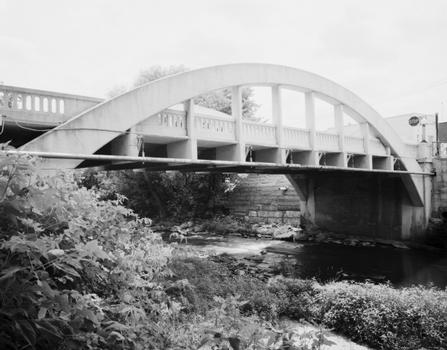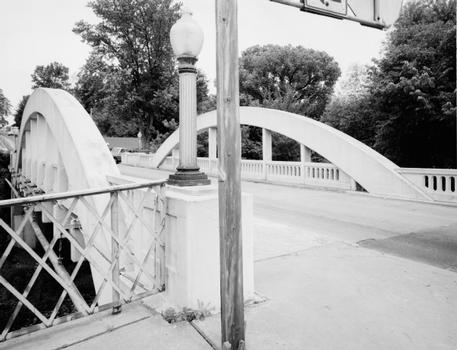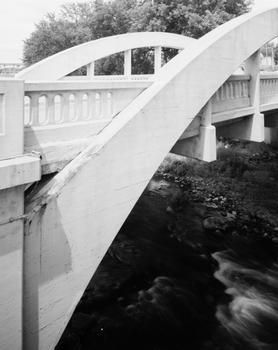General Information
Project Type
| Structure: |
Through arch bridge |
|---|---|
| Function / usage: |
Road bridge |
| Material: |
Reinforced concrete bridge |
Location
| Location: |
Chippewa Falls, Chippewa County, Wisconsin, USA |
|---|---|
| Address: | Spring Street |
| Crosses: |
|
| Coordinates: | 44° 56' 10.57" N 91° 23' 25.95" W |
Technical Information
Dimensions
| arch span | 27.45 m |
Materials
| arch |
reinforced concrete
|
|---|
Chronology
| August 1916 | Construction begins. |
|---|---|
| October 1916 | Opened for traffic. |
Historical Documentation (HAER No. WI-37)
The Spring Street Rainbow Arch Bridge is Wisconsin's only remaining example of the J. B. Marsh patented design.1 The concrete and steel structure spans a small creek in the residential area of Chippewa Falls. Built in 1916, the bridge replaces an earlier span which collapsed only six months after its construction. The graceful bowstring arch with its massive concrete exterior is a landmark for the area and remains in excellent condition.
Description
The Spring Street Bridge crosses Duncan Creek with a total clear span of 93 feet. Total width of the "bridge is 29 feet, 3 inches. A 20-foot roadway crosses the structure and contains one 8-foot sidewalk. The massive arch forms are composed of steel truss work encased in concrete. The bridge design received its nickname "rainbow arch" because of the characteristic enlargement of the arch forms as they approach the abutments. The arch, which has a total rise of 20 feet, expands from 3 feet radially at the crown to over 52 inches at the springing points. The floor deck is hung from the arches, using eight steel hangers per side also enclosed in concrete. Steel I-beams attached to the hangers support the roadway.
All of the original ornamental and aesthetic components of the bridge remain. A cast cement railing integrated into the arch and vertical members encloses the structure. Original cast steel lamp standards with ionic capitols and glass globes stand at all four corners of the bridge. The interior railing contains a cast plaque identifying the Iowa Bridge Company of Des Moines as the contractor and crediting the Board of Public Works and other key politicians as instrumental in the bridge's construction.
The bridge plate reads:
Marsh Rainbow Arch Bridge
Patented August 6, 1912
Built By
Iowa Bridge Company
Des Moines
1916
Board of Public Works
Geo. E. Dee Mayor, W.K. Bowe City Atty., J.T. Kurd City Eng.
Site Development
The history of the Spring Street crossing is filled with much superstition and many calamities, including at least two deaths and many reported losses of personal property. Reports labeling the crossing a 'hoodoo' reach as far back as the early 1880s.4 The earliest victim of the Spring Street crossing was a highway workman named Jeff Murphy who died when a dump cart he was operating while filling the east abutment broke away and fell down the embankment. In 1880, an iron bridge collapsed while Louis Blum, who was driving a wagon loaded with Leinenkugel beer, was crossing. The mishap killed one of the horses and destroyed a complete shipment of beer, causing many of the city residents to "die of thirst."5 Paul Felix, a local contractor was killed in 1911 while working on the underside of the bridge. While Felix removed a scaffold, a large timber struck him in the head.
On July 20, 1915» the previous steel truss bridge across Duncan Creek at Spring Street was deemed unsafe. The City Board of Public Works proceeded to advertise for bids on a new concrete structure at this site. The contract was awarded on August 27th to the lowest bidder, Thomas E. Wooley of La Crosse, Wisconsin, for a price of $7*947. The concrete span was completed by December 7» 1915. and accepted by the city.
On Sunday, April 1, 1916, the concrete bridge collapsed under the pressure of the annual spring floods. Public outrage at the failure of the new structure led the Common Council to adopt a resolution to conduct an investigation and sue the person responsible for its collapse. The investigation concluded that Wooley was not at fault. The bridge's collapse resulted from severe flooding, the hasty completion before the winter freeze, and the improper design of the center pier footings.^ The rubble from the bridge was bulldozed by a crew of expert stone wreckers from Camp Guthrie and the abutments made ready for a new span for a total oost of $1,120.
In June 1916, the City Common Council requested that the city engineer prepare plans and estimates for a new bridge at Spring Street. The city engineer, J. T. Kurd, recommended a concrete reinforced concrete structure, since a steel structure would be of no savings, due to the war's inflation of metal prices. Kurd's plans called for a simple three-centered arch span with neo-classical styling. On June 21, a request for bids on the project was announced in the local papers. The notice also stated that alternative designs by the contractors would also be considered.
Bids were received from three companies by the July 18 deadline. The Iowa Bridge Company of Minneapolis, Minnesota, received the contract for construction of a concrete arch structure according to the plans of the Marsh Engineering Company of Des Moines, Iowa. Other companies bidding for the contract were the Illinois Bridge Company of Chicago and the Illinois Bridge Company of Jacksonville, Illinois. The Iowa Bridge Company's Marsh design estimate was substantially lower than their "bid on the city engineer-designed structure. The company's total bid was $13,950. The City Council estimated that a considerable amount of money could be saved by employing the present abutments and reusing additional reinforcing steel the city had on hand. The total estimate was eventually reduced by $1,300.
The Iowa Bridge Company's bidding was supervised by company executive Grant Montgomery. While this was the first bridge of its kind in Wisconsin, Montgomery assured the council of the design's strength and widespread use in Europe. The company had recently completed a number of these type of bridges for the Federal Government in Yellowstone Park. Montgomery personally supervised completion of the span, and the bridge opened to pedestrian traffic on October 15, 1916.
Construction
The Marsh Arch design eliminated many of the time consuming tasks involved in traditional concrete construction. Complete steel trusses were employed for reinforcement in the arches. The steel trusswork was assembled on the ground and then lifted in place. Angle irons placed in sets of four, eight to a side, were attached to the arch and served as the hangers for the deck. Steel truss members were also used for the bottom chords. The steel trusses were used to support their own formwork, thus eliminating the need for costly and time consuming falsework construction beneath the structure. Large steel I-beams were welded to the hangers across the width of the bridge. After formwork was attached to these beams, the contractor poured the concrete decking. Once the deck had cured, concrete casting began on the arches and hangers.
The Spring Street design is of the fixed type, meaning that both ends of the massive arches are set securely into the concrete embankments. Variations of the basic patented design allowed for arches set on cast steel rockers, allowing a minimal amount of movement. In the Chippewa Falls example, the entire amount of force generated by the bridge is absorbed as horizontal thrust of the arches in the embankments.
Source: Historic American Engienering Record, written historical and engineering data for Spring Street Bridge (Marsh Rainbow Arch Bridge) HAER No. WI-37
Participants
- James B. Marsh (designer)
Relevant Web Sites
Relevant Publications
- (1984): Great American Bridges and Dams. A National Trust Guide. John Wiley & Sons, New York (USA), pp. 238.
- About this
data sheet - Structure-ID
20003640 - Published on:
17/06/2002 - Last updated on:
05/02/2016










